NASA holds the key to our future more than any other federal agency. What NASA plans now and can subsequently accomplish will determine where the U.S. will be 10, 20, 50 and 100 years from now, not just in space but with respect to our entire economy.
•
The ultimate goal of astrophysics is to understand the origin and evolution of the universe.
When Columbus and other early navigators set out on their voyages of discovery across the oceans, they launched a global diffusion of European culture with an attendant increase in our knowledge of the world and utilization of its resources. Now 500 years later, we have a parallel. Space is a vast ocean and our satellites, probes and astronauts moving out into it can launch a humanization of space with an attendant increase in our knowledge of the universe and utilization of its resources.
Sputnik catapulted the world into the Space Age with the first artificial satellite. The earth is now surrounded with thousands of them, like a swarm of bees, most in low orbit circling the Earth in as little as 90 minutes but with others in higher, slower orbits, particularly the Clarke or geostationary orbit where a satellite remains poised above a fixed point on the Earth's equator.
When Arthur C. Clarke proposed the geostationary satellite as a solution to the world's communication problems a dozen years before Sputnik, many regarded his idea as visionary and far-fetched. But today communication satellites in the Clarke orbit are a multi-billion dollar business providing services for millions, employment for thousands and stock dividends for thousands more. These satellites carry an increasing fraction of the world's telephone, TV and civilian and military messages. For example, today's national and international businesses operate more efficiently by linking all intercenter voice, data, graphics and video traffic for all their scattered offices and factories via Clarke satellite while entire newspapers are relayed for simultaneous publication in distant cities by Clarke satellite. The list of other applications is long and growing.
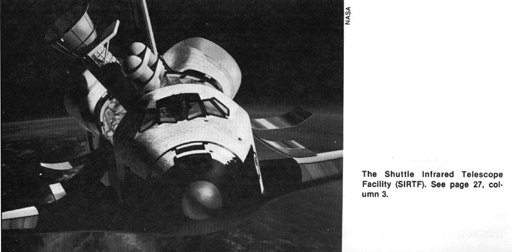 The role of the Space Shuttle in expanding our activites in space is crucial. It has opened a new era of space utilization, facilitating the deployment of satellites of all kinds, making them less expensive and permitting their maintenance in space and/or their return to Earth for modification and refurbishing.
The role of the Space Shuttle in expanding our activites in space is crucial. It has opened a new era of space utilization, facilitating the deployment of satellites of all kinds, making them less expensive and permitting their maintenance in space and/or their return to Earth for modification and refurbishing.
Columbus and other early navigators used the stars and magnetic compass to find their way. Modern space craft rely on our increased knowledge of the heavens and on sophisticated electronic technology for guidance.
Our future is tied to space and its utilization. The National Aeronautics and Space Administration (NASA) holds the key to this future more than any other federal agency. What NASA plans now and can subsequently accomplish will determine where America will be 10, 20, 50 and 100 years from now, not just in space but with respect to our entire economy. We are part of space and space is part of us.
NASA has recently formulated a number of imaginative, exciting, yet practical, plans for future space instruments that can revolutionize our knowledge of the universe and our ability to utilize its resources. In this article I describe some of these astronomical instruments with a few brief comments. But to put these devices of the future in perspective, let me review some of the instruments NASA has already put into space and ones now being readied for orbit in the next few years.
It must be kept in mind that putting a complex instrument into space is not an overnight affair; it takes years of planning and more years of actual construction before a satellite is ready to go up. From initial plans to orbit can easily take 10 years or more.
Early NASA space instruments were designed to explore regions of the electromagnetic spectrum (see illustration above) which can't be observed from the Earth's surface because the waves are so short they are blocked by the Earth's atmosphere or so long they are cut off by the Earth's ionosphere. Thus, at the short end, studies of gamma rays, x-rays and the shorter ultra-violet rays require instruments in orbit above the Earth's atmosphere. Although some early x-ray observations were made from rockets rising above the Earth's atmosphere for a few moments, these provided only fleeting, tantalizing glimpses. At the long wavelength end, studies of kilometer radio waves also require instruments above and beyond the Earth's ionosphere.
Thus, one of the first NASA space observatories was an x-ray satellite on which planning began actively in 1963. Seven years later this satellite, called UHURU, was launched from Africa. This was followed by more advanced x-ray satellites including the High Energy Astronomical Observatory-1 (HEAO-1) launched in 1977 and HEAO-2, called Einstein, launched in 1978.
In the mid-1960s the U.S. orbited several satellites, code-named Vela, to monitor the Nuclear Test Ban Treaty by means of gamma-ray detectors. These detectors have recorded a number of short intense bursts of gamma rays characteristic in many ways of nuclear explosions in space. They appeared to have come from somewhere beyond the solar system but their cause and origin are not known.
Subsequently, a number of gamma-ray satellites were orbited by NASA including SAS-2 in 1972, COS-2 and SAS-3 in 1975 and HEAO-3 in September 1979. On March 5, 1979, a number of U.S. and Soviet satellites detected an intense gamma-ray burst that seemed to come from the Large Magellanic cloud at a distance of 160,000 light-years, thus localizing the direction of at least one of the bursts.
For the shorter ultra-violet wavelengths NASA put up the orbiting Astronomical Observatory-2 (OAO-2) in 1968 and the Copernicus Satellite (OAO-3) in 1972. The International Ultra-violet Explorer (IUE-A) was a joint U.S.-European venture launched in 1978.
For the long radio wavelengths NASA orbited the Radio Astronomy Explorer-A (RAE-A or Explorer 38) in 1968 and in 1973 RAE-2 was orbited, not around the earth but around the moon in order to take advantage of the Moon's shielding to reduce interference from radiations from the Earth and Sun at wavelengths of 100 to several 1000 meters. The terrestrial interference for which shielding was needed did not come from manmade transmitters but rather from a natural radiation from the Van Allen particle belts above the Earth's ionosphere. At times the power of this radiation reaches power levels of one gigawatt (one million kilowatts).
Our society is now at a unique juncture where:
(1) sensitive instruments have been developed for observing all across the electromagnetic spectrum from the shortest gamma rays to the longest radio waves;
(2) space flight has been achieved so that these instruments can be orbited above the Earth's atmosphere where essentially the full electromagnetic spectrum can be observed; the Space Shuttle is an important step in this development;
(3) microwave technology has been developed to the point where satellites and probes can be remotely controlled by radio links and pictures and observational data telemetered to Earth control centers;
(4) computer technology has been developed that permits the storage, processing and enhancement of the vast amounts of data acquired.
We are at a point in time where these technological developments can be applied to produce further rapid advancements in our knowledge and utilization of space and the universe. Many important new discoveries may be in the offing.
Astronomical space exploration follows a logical sequence:
(1) Surveys to map the sky and pinpoint objects.
(2) Studies of individual objects discovered in the surveys.
(3) More detailed and extensive studies of individual objects with specialized instruments and techniques.
This sequence will be noted in the missions accomplished to date and planned for the future.
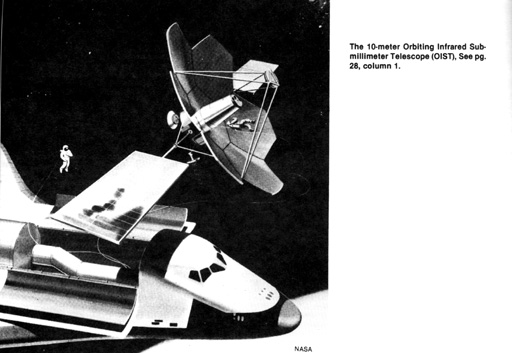 In cooperation with the Space Science Board of the National Academy of Sciences, with other groups and with individual scientists, a number of projects have been planned by NASA to take advantage of the new opportunities space offers.
In cooperation with the Space Science Board of the National Academy of Sciences, with other groups and with individual scientists, a number of projects have been planned by NASA to take advantage of the new opportunities space offers.
Not all of the following satellites and instruments planned for the future will be flown since development is in a constant state of evolution. What is being learned is continually being applied to improve and refine later instruments and observations. Funding must also be authorized to complete plans and to construct and orbit the instruments.
With the 2 historic flights of the Space Shuttle Columbia April 12-14, 1981, and the record flight Nov. 12-14, 1981, the U.S. has in initiated a new era of greatly increased capability which is essential for our continued exploration and ultimate utilization of space. NASA's future plans are dependent on frequent flights by the Space Shuttles.
[Note. The following table shows a reorganization of the list and related illustrations of satellites and instruments from that shown in the magazine article.]
| ST |
The Space Telescope with 2.4 meter mirror for optical and ultra-violet observations will be one of the Space Shuttle's first launching assignments. Above the Earth's atmosphere the new telescope will afford astronomers a vastly improved view of the cosmos. |
|
| GRO |
The Gamma Ray Observatory will study the full range of gamma ray phenomena over the whole sky at high sensitivity and resolution. It will carry a burst detector, a high resolution spectrometer, a broad band spectrometer, a double Compton telescope and a high energy telescope.
| 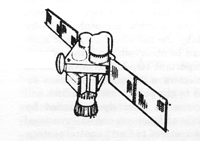 |
| GTE | The Gamma-ray Transient Explorer will study gamma-ray pulses (discovered by the Vela satellites) with an all-sky coverage, gamma-ray bursts from the Sun and electron-positron pair annihilation radiation from space.
| |
| AXAF | The Advanced X-ray Astrophysics Observatory is an X-ray satellite for studying structure and composition of stars, quasars, pulsars and black holes and also for studying the elements in space.
| 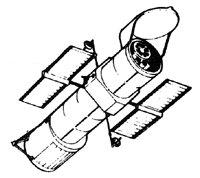 |
| XTE | The X-ray Timing Explorer will study the rapidly pulsing x-ray emitting objects. |
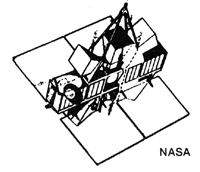 |
| XRO | The X-ray Observatory is planned for continuing and extending studies of earlier x-ray satellites. |
 |
| LAMAR | The Large Area Modular Array of Reflectors is planned for mapping the x-ray sky at high sensitivity, 1 arc minute resolution and 1 degree field of view. |
|
| SXE | The Soft X-ray Explorer is for studying soft (or long wavelength) x-rays in the 1 to 10 nanometer range.
| |
| EUVE | The Extreme Ultra-Violet Explorer will conduct an all-sky survey at short ultra-violet wavelengths (10 to 100 nanometers) for the detection of stars within about 300 light-years to provide new information about the local star population, star evolution and star dynamics.
| |
| FUSE | The Far Ultra-violet Spectroscopy Explorers are to make spectral analyses of distant stars, galaxies and interstellar matter in the 90 to 120 nanometer wavelength range. Quintuply ionized oxygen (OVI) has a fundamental line at 103 nanometers which is a unique tracer of hot gas.
| 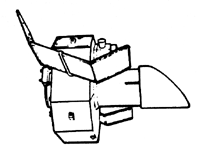 |
| EUVSE | The Extreme Ultra-Violet Spectroscopy Explorer is to perform spectral analysis of specific celestial objects in the 7 to 100 nanometer wavelength range, including white dwarf stars, flare stars, and highly variable stars.
| |
| SAE | The Simultaneous Astronomical Explorer will monitor and study variable phenomena at ultra-violet and optical wavelengths from 4 to 900 nanometers. Of particular interest are flare stars, quasars, BL Lacertae objects, and Seyfert galaxies.
| |
| Star Lab | For investigations of space within the solar system, our galaxy and between galaxies at ultra-violet, optical and infra-red wavelengths a 1-meter diameter telescope will be mounted in the cargo bay of the Space Shuttle.
| 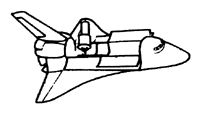 |
| VLST | The Very Large Space Telescope is to be of 6 to 10 meters diameter for ultra-violet, optical and infra-red observations of distant objects to help establish such things as the characteristics and dynamics of galaxy clusters (as the one in Virgo) and to extend Hubble's redshift measurements to more distant galaxies. The components for this telescope would be brought up by the Space Shuttle for assembly in orbit.
| 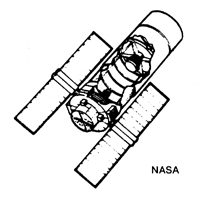 |
| TAT | The 100 meter Thinned Aperture Telescope. This telescope, of 100 meter diameter, would consist of a narrow ring-like reflector made up of an array of individual mirror elements automatically kept in position and alignment. The telescope would provide the high resolution and sensititivy at ultra-violet, optical and infra-red wavelengths needed to detect planetary systems around other stars. Such a discovery would be a momentous event. Whereas the Space Telescope has the potential of discovering Jupiter sized planets associated with other stars, TAT could detect considerably smaller planets.
| 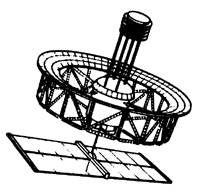 |
| COSMIC | The Coherent Optical System of Modular Imaging Collectors is to provide the increased sensitivity and resolution needed to extend productive optical research programs into the 1990s and beyond. Plans under consideration involve high-resolution optical interferometers.
| 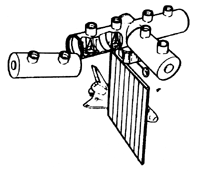 |
| MLSE | The Molecular Line Survey Explorer will study the evolution of stars through the emission of their molecules at long infra-red wavelengths (0.1 to 1 millimeters). There are about 50 known kinds of molecules that have been found in giant gas clouds of our galaxy.
| |
| SIRTF | The Shuttle Infra-Red Telescope Facility is to provide a million-fold improvement over present ground-based telescopes at 2 to 200 micro-meter wavelengths. This is needed to follow up on sources discovered in infra-red surveys now being completed. An 85-centimeter telescope cooled to about 20K (or 20 degrees Celsius above absolute zero) would be mounted in the cargo bay of the Space Shuttle. Observations should provide new insights into star and galaxy formation, and may lead to the discovery of previously undetected red dwarf stars which may constitute some of the missing mass of our galaxy.
| |
| COBE | The Cosmic Background Explorer is planned for an infra-red-radio survey of the sky between 1 micrometer and 13 millimeter wavelength to determine the spectrum of the 3 degree cosmic background (primordial fireball) radiation and to look for any irregularities in its angular distribution. The satellite orbit will be so oriented that the Sun will always be to one side and the Earth always below the observing direction to help prevent solar and terrestrial radiation from reaching the measuring instruments which will be kept refrigerated at a temperature close to absolute zero.
| |
| OIST | The Orbiting Infra-red Submillimeter Telescope will study the 3 degree cosmic background radiation, the evolution of gas clouds into stars, the properties of dust grains in space and the formation of quasars. Plans contemplate a 10 meter diameter deployable reflecting telescope for operation at 30 micrometer and longer wavelengths with resolution of about 10 arc seconds.
| |
| LADIT | The Large Ambient Deployable Infra-red Telescope is for studying stars, quasars, galactic structure and galaxy evolution. A telescope of 10 meter diameter or more operating at 30 to 1000 micrometer wavelengths is contemplated.
| |
| IRIS | The Infra-Red Interferometer in Space is to provide increased resolution at infra-red wavelengths by using 3 SIRTF-type telescopes mounted on a 100 meter platform as one possibility.
| |
| VLSI | The Orbiting Very Long Baseline Interferometry Observatory involves plans which contemplate a 30 to 60 meter diameter parabolic dish antenna in orbit to operate in conjunction with earth-based radio telescopes for providing more baseline combinations (in separation and orientation) than is possible with present entirely earth-based telescopes. Operation would be at 1 to 30 centimeter wavelengths. Earth-based radio interferometers with intercontinental base lines have produced radio pictures of celestial objects at resolutions almost a thousand times better than can be achieved photographically with the largest optical telescopes. The addition of an orbiting radio telescope would make it possible to produce significantly improved radio pictures.
| |
| HNE | The Heavy Nuclei Explorer is to study the origin and path of travel of cosmic ray particles to give insights regarding the formation of atomic nucleii. Heavy, high-energy particles are best for such studies because they are deflected least by magnetic fields.
| |
| CRO | The Cosmic Ray Observatory is for studying the origin, acceleration and propagation of cosmic ray particles which permeate space like a gas. The particles constitute a sample of matter from outside the solar system and consist of many nuclei that range over the entire periodic table. Particle telescopes in CRO will look for particular elements.
Cosmic rays consist of particles (such as protons) as distinguished from electromagnetic radiation or waves (also sometimes called rays, as for example, x-rays). The Earth's atmosphere impedes the passage of these particles to the Earth's surface so cosmic ray observations have in the past been done from high altitude balloons. In space above the atmosphere their detection and study will be facilitated. Many of the particles are atomic nuclei that are believed to have originated in distant, ancient stellar explosions or other violent events.
| |
| LIST OF ASTRONOMICAL SATELLITES AND KEY TO ABBREVIATIONS |
AIE: Advanced Interplanetary Explorer
Ariel: United Kingdom-5, X-ray and ultra-violet
AXAF: Advanced X-ray Astrophysics Facility
BDCE: Beta Decay Clock Experiment
COBE: Cosmic Background Explorer (infra-red)
Copernicus: Orbiting Astronomical Observatory-3
COS: COsmic ray Satellite
COSMIC: Coherent Optical System of Modular Imaging Collectors
CRO: Cosmic Ray Observatory
Einstein (HEAO-2): High Energy Astronomical Observatory-2 (HEAO-2) (X-ray)
EUVE: Extreme Ultra-Violet Explorer
EUVSE: Extreme Ultra-Violet Spectroscopy Explorer
Explorer 37: x-ray
FUSE: Far Ultra-violet Spectroscopy Explorer
GP-A: Gravity Probe-A
GP-B: Gravity Probe-B
GTE: Gamma-ray Transient Explorer
GRO: Gamma-Ray Observatory
HEAO: High Energy Astronomical Observatory
HMRE: Hydrogen Maser Redshift Experiment for test of Einstein theory
HNE: Heavy Nuclei Explorer
IRAS: Infra-Red Astronomy Satellite (1982)
IRIS: Infra-Red Interferometer in Space
IUE-A: International Ultra-violet Explorer
LADIT: Large Ambient Deployable Infra-red Telescope
LAMAR: Large Area Modular Array of Reflectors (x-ray)
MLSE: Molecular Line Survey Explorer
OAO: Orbiting Astronomical Observatory. Ultra-violet
OIST: Orbiting Infra-red Submillimeter Telescope
OSO: Orbiting Solar Observatory
OST: Orbiting Submillimeter Telescope
RAE-A: Radio Astronomy Explorer-A. (Explorer 38)
RAE-B: Radio Astronomy Explorer-B. Lunar orbit
SAE: Simultaneous Astronomical Explorer
SIRTF: Shuttle Infra-Red Telescope Facility
Star Lab: 1-meter telescope on Space Shuttle for optical, ultra-violet and infra-red
ST: Space Telescope (Ultra-violet and optical)
SXE: Soft X-ray Explorer
Syncom-2: Synchonous communications satellite
TAT: Thinned Aperture Telescope of 100-meter diameter
UHURU: X-ray Observatory
Vela: Gamma-ray Observatory
VLBI: Orbiting Very Long Baseline Interferometer (radio)
VLST: Very Large Space Telescope
VOIR: Venus Orbiting Imaging Radar
XRO: X-Ray Observatory
XSE: X-ray Spectroscopy Explorer
XTE: X-ray Timing Explorer
|

![[NAAPO Logo]](../../Images/NAAPOsm.jpg)
![[NAAPO Logo]](../../Images/NAAPOsm.jpg)